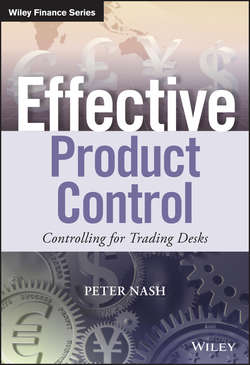Читать книгу Effective Product Control - Nash Peter - Страница 25
На сайте Литреса книга снята с продажи.
Part 1
Working in Product Control
CHAPTER 3
Key Stakeholders
Market Risk
ОглавлениеMarket risk is the risk that the desk's portfolio will rise or fall in value due to changes in market prices, which can lead to either profits or losses for the bank. As a bank wants to limit the losses incurred from market fluctuations, they will set an overall market risk limit for the group at board level. These group-level limits are then transformed into smaller business- and desk-level limits, which are applied across the various trading desks. Limits cover such things as:
• Maximum loss for moves in interest rates, foreign exchange rates, credit spreads or volatilities.
• Concentration limits on exposures in various maturities or even various countries.
• Types of products that can be traded.
• Daily P&L amounts.
The market risk function within a bank, sometimes known as market risk control, falls within the mandate of the chief risk officer, who is also responsible for the credit and operational risk of the firm.
Market risk is responsible for:
• Agreeing on, with the board and heads of business, the market risk limits that the trading desk can run.
• Quantifying, monitoring, and reporting the market risk exposures of the trading desk.
• Authorize short-term limit extensions or ask for positions to be closed to bring a desk back within agreed limits.
• Running stress-testing scenarios to highlight the bank's potential P&L in exaggerated market movements.
• Escalating market risk limit breaches to the senior management in market risk and the business.
• Model validation and approval.
As with any control function, it is important that market risk remain independent of the trading desk that they are aligned to.
Market risk rely on product control for the following:
• The official daily P&L which highlights what positions are generating the desk's P&L.
• A clean MTM P&L, which will be used for VaR back testing.
• Independently verifying the end of day marks (prices, rates and volatilities) used to revalue the desk's open positions.
• Advice on the availability of market prices when new products are proposed.
Product control (including valuation control) rely on market risk for:
• Market risk exposures (used for risk based P&L estimates).
• Approving and calibrating the financial models used to generate fair values.
• Assistance in quantifying financial model reserves.
• Assistance in determining the banking book and trading book classifications.
• Insights into the financial markets, particularly when quantifying prudential valuations for regulators.
• Allocating trading positions in the fair value hierarchy and determining fair value through the independent price verification process.
